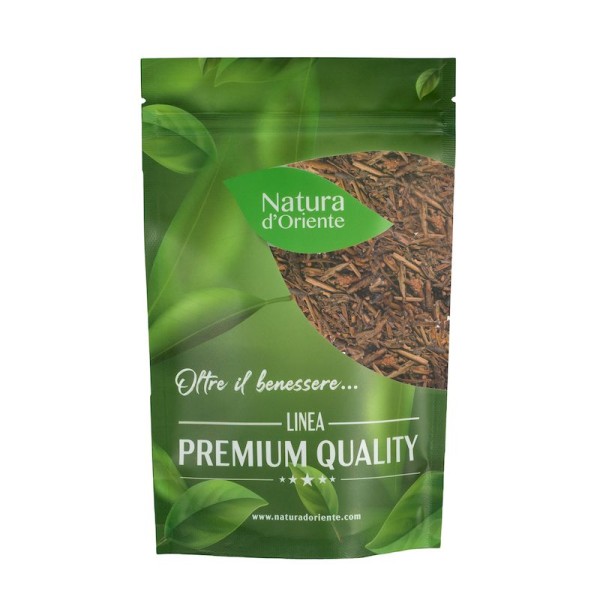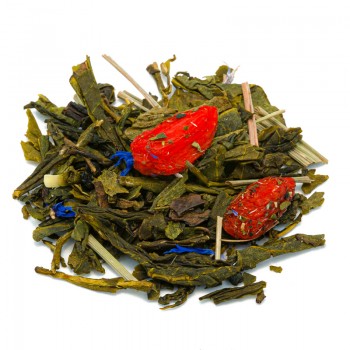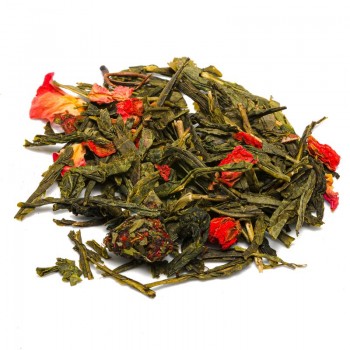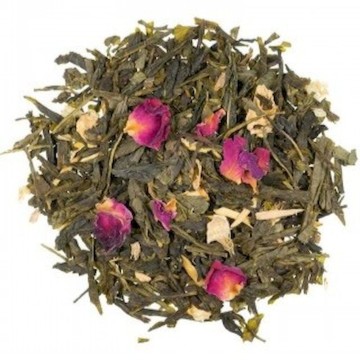Roasted Kukicha green tea
Among the green tea varieties, this particular infusion derives from a different practice of harvesting from the plant than usual. This Kukicha Japan originates from the Kagoshima area, where not the leaves of Camellia sinesis are harvested (as usual), but other parts of the plant. Kukicha derives from the roasting of stems, stems and twigs of the tea plant, with a process that waits at least 3 years before harvesting. For this reason, we speak of "three-year tea", the result of aging which makes it a decaffeinated Japanese tea.
The twig already contains less theine than other parts, finally the roasting process modifies its taste characteristics. The lightly roasted stems provide a sweetness that balances the bitter notes of the tea, and the fibers from the stems create a full-bodied tea. Little bitter and without astringency, it gives sweet nutty or chestnut nuances - sometimes hints of honey, brown sugar and dried wood. The scent is enveloping, vegetal and reminiscent of the plant - especially in the Kukicha tea version. Shows a light fawn color due to the roasting. It is a green tea with a very refined taste, preferred by many people for its high drinkability and without astringent notes.
Properties and benefits
This particular infusion, as mentioned, does not contain theine (caffeine), and can be drunk at any time of day or evening. The very low alkaloid content makes Kukicha suitable for anyone looking for the benefits of green tea, avoiding the exciting effects of theine (agitation, headache, increased heart rate, increased blood pressure). In addition, it makes other beneficial nutrients available, Kukicha containing vitamins A, C, vitamins of the B complex. In addition to minerals such as copper, selenium, manganese and zinc. The good calcium content of Kukicha green tea is an appreciated property. One cup contains more calcium than several glasses of cow's milk. It is therefore useful for the well-being of bones, teeth and for the correct functioning of muscle contraction and the transmission of nerve impulses. Kukicha green tea also contains fluoride, which is useful together with calcium to maintain the well-being of bone tissue and tooth enamel. Compared to other teas while it contains little caffeine, this green tea shows a higher level of L-theanine, an amino acid produced by the roots of the plant.
Before getting to the leaves, it passes through the twigs and stems that make up this tea. L-theanine helps maintain a state of serenity, relaxing the nervous system; reduces stress but avoids the drowsy feeling of other beverages. It usually balances theine (here almost absent), and in this tea it creates a beneficial effect for concentration and attention, avoiding the excitement typical of coffee. In Kukicha there is also a good content of antioxidants such as polyphenols and tannins; molecules that counteract cellular aging and free radical damage to cells. An important nutrient of green teas such as Kukicha is ellagitannin, which gives effects known in popular medicine of the past as natural anti-inflammatories.
A useful element for digestive well-being, promoting the growth of good intestinal bacteria, to improve transit of food and avoid constipation disorders. Furthermore, this Japanese green tea is useful for those suffering from stomach acidity because it gives an alkalizing action that decreases acidity, if associated with a correct diet.
This type of Japanese tea has been promoted for its ability to alkalize the body, within whole and macrobiotic diets. Catechins are present in smaller quantities due to the roasting process, but they still perform a useful action for those who want to combine green tea with a detox diet. Kuchina as green tea has purifying qualities, encourages diuresis for a draining action and simplifies the expulsion of excess liquids and toxins. It can counteract water retention, helping against swelling in some areas of the body. In terms of antioxidants, Kukicha tea also contains a lot of vitamin C, known for the defense of the immune system, skin and eyes. Also suitable for the elderly, Kukicha is used as a drink during meals by adding apple juice or rice malt.
Origins and History of cultivation
The name of Kukicha green tea, also called Bancha Kukicha tea, derives from the term kuki "sprig", immediately indicating its origin. It comes from the collection of the green parts of the Camellia sinensis plant: twigs, stems and stems. The tea leaves are eliminated, and a suitable mixture is prepared for the infusion of the harder elements. This type of tea was invented in Japan, in the province of Shizuoka, as a cheap tea for less well-off populations.
During the finest processing of tea, the stems and stalks of the plant were discarded. The workers of the plantations, to avoid waste, began to use the twigs, using them for a different infusion: the economic version of green tea. Its origin, in fact, has revealed excellent nutritional properties, especially for the content of theanine and the absence of caffeine. In the roasted Kukicha green tea process, the plant parts are gathered, trimmed, cut evenly, and then roasted.
This results in a darker tea, the fruit of stems, stems and twigs blended together - no part of the harvest is wasted. When Kukicha is made with Gyokuro tea (high quality) it is called "Karigane" or "Shiraore". Kukicha made with Bancha tea is considered low quality. Very good quality can come from the spring harvest Sencha, from the twigs that they are roasted to a rich cocoa-colored hue, to be made into Kukicha. The appearance of this roasted Kukicha tea can be described as a bird's nest. In Japanese tradition, Kukicha can be consumed with and after meals to aid digestion. It often accompanies rice and vegetable dishes, with its delicate and sweet flavour. Kukicha was introduced in Europe only recently by George Ohsawa, the founder of the macrobiotic diet. It was he who spread it as the "tea of three years” (the age that the plant from which the twigs are harvested must be).
Plant and flowers
Kukicha originates from the tea plant, Camellia sinensis, sometimes called Thea sinensis. It is a shrub native to Southeast Asia, now also cultivated in other countries with tropical climates. The plant belongs to the Theaceae family, and represents a genus that brings together around 250 species of evergreen trees and shrubs.
In the wild, Camellia sinensis can even reach 9 meters in height, but it is usually grown reduced to a low bush, to facilitate the collection of leaves. In this case, for Kukicha, to encourage the collection of twigs, stalks and stems. It is pruned often to encourage the development of the young tea leaves. The woody shrub is much branched, and the young branches are reddish. Gives fragrant flowers, which form on the branches. The shape and color also depend on the variety of the plant, which has been selected and grown in abundance since the last century.
Nutritional values of roasted green Kukicha
This Japanese tea contains good amounts of calcium, and some antioxidant polyphenols including EGCG Epigallocatechin gallate, and the amino acid L-theanine. Contains a low theine content (about 25 milligrams in a cup). In addition, it makes available small amounts of vitamin C (about 2%) and B vitamins (thiamin, riboflavin, niacin).
How to prepare roasted green Kukicha
Kukicha green tea is obtained by placing in a cup (250 ml), about 3-5 grams of the and toasted infusion preparation, with water at 80 °C. Leave to infuse for 2 to 3 minutes, before drinking the Japanese green tea infusion. If you want a more robust flavor, you can let it steep a few more minutes.
Following the oriental procedure of multiple infusions, the same leaves can be infused several times (about 5 g). We proceed with the first infusion of 1 minute, and then a second infusion of a few seconds (the water is always at the same temperature). The Western method uses a smaller amount of tea and longer steeping times, while the Eastern method uses larger amounts and shorter steeping times. It can be served both hot and cold. Kukicha tea is also great without sweeteners, but you can add sugar, honey, or milk and honey if you like.
Roasted Kukicha green tea: side effects and contraindications
Although Kukicha green tea does not have the side effects associated with caffeine, it is advisable to respect the recommended doses, to prevent the high levels of tannins from hindering iron absorption. Therefore, for those suffering from anemia, it is recommended to integrate Kukicha tea with foods rich in iron.









 No reward points for this product.
No reward points for this product.
![green tea hemp mango [Natura d'Oriente]](https://www.naturadoriente.com/3381-home_default/green-tea-mango.jpg)






![Green Tea Sencha Kombucha [Natura d'Oriente]](https://www.naturadoriente.com/3380-home_default/-green-tea-sencha-kombucha-.jpg)


![Green tea Jasmine and jasmine [Natura d'Oriente]](https://www.naturadoriente.com/3373-home_default/green-tea-jasmine-and-jasmine-.jpg)




